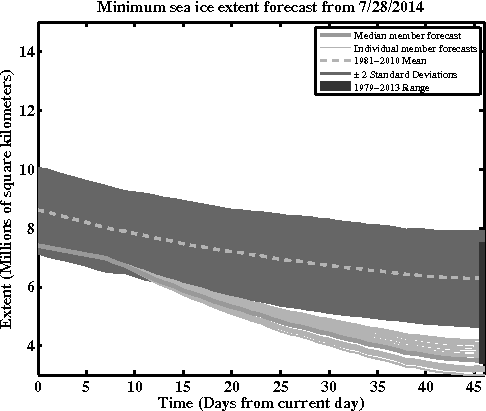Steven M. Cavallo |
|
|
|
Real-time images and animations
Arctic sea ice forecasts
Ensemble forecast of upcoming minimum sea ice extent
|

Minimum sea ice extent forecasts showing individual ensemble members (solid, light gray) and the ensemble median (solid, dark gray). The 1981-2010 climatology is shown for comparison (light, dashed gray) along with the +/- 2 standard deviation range (dark gray shading). The dark gray vertical bar on the last time denotes the range of minimum sea extent observed from 1979-2012. Ensemble forecasts are computed from a stochastic model by Steven Cavallo using past observations combined with the most recent estimates of the atmospheric state using NCEP/NCAR reanalysis data.
Loop of this year's forecasts
Loop of previous year's forecasts |
500 hPa height loop and latest image
Colors show the standardized anomalies of 500 hPa geopotential heights from NCEP/NCAR Reanalysis data over the past 30 days, while solid (dashed) contours show positive (negative) sea level pressure standardized anomalies over the past 30 days with a contour interval of 0.5 standard deviations. Anomalies are computed with respect to the 1981-2010 long-term mean.
|
Error vs. lead time
Ensemble forecast error (Forecast - observed) in minimum sea ice extent from 1990-2012 as a function of forecast lead time. The median member is denoted by the gray contour while the mean ensemble range is denoted by the light gray shading. |
Mean absolute error vs. lead time
Mean absolute forecast error in minimum sea ice extent from 1990-2012 as a function of forecast lead time. The median member is denoted by the solid gray contour while the mean ensemble
range is enclosed by the gray shading. Light-dashed gray are mean absolute errors for persistence forecasts, while medium-dashed (dark-dashed) are those from first-(second-) order forecasts.
|
GFS tropopause maps: Past 7 days - 7 day forecast
Dynamic tropopause (2 PVU surface) plots from 0.5 degree GFS analyses over the past 7 days, and 0.5 degree GFS forecasts over the next 7 days.
|
Tropopause potential temperature
Tropopause potential temperature (colors, 1 K interval) and sea level pressure (contours, 4 hPa interval, greatest contour 996 hPa)
|
Tropopause potential temperature ensemble spread
GEFS ensemble spread in tropopause potential temperature (colors, 0.1 K interval) and tropopause potential temperature of control (contours, 5 K interval) from latest 00/12 UTC forecast.
|
Arctic tropopause potential temperature
Tropopause potential temperature (colors, 1 K interval) and sea level pressure (contours, 4 hPa interval, greatest contour 1004 hPa). The approximate extent of sea ice is denoted with the thick, dark gray contour.
|
Sea ice concentration, tropopause potential temperature, sea level pressure
Near-real-time DMSP SSM/I-SSMIS daily polar gridded sea ice concentration (colors, fraction between 0 and 1), GFS tropopause potential temperature (black contours, 5 K interval) and GFS sea level pressure (green contours, 4 hPa interval). Sea ice concentrations obtained from the National Snow and Ice Data Center (NSIDC).
|
Tropopause potential temperature, SLP, vorticity advection
Tropopause potential temperature (colors, 0.5 K interval), sea level pressure (light contours, 4 hPa interval), and 500 hPa positive vorticity advection by the thermal wind (dark contours)
|
Tropopause pressure
Tropopause pressure (colors, 10 hPa interval)
|
Tropopause winds
Tropopause wind magnitude (colors, 2 m s-1 interval)
|
Other plots |
GFS Hovmoller of midlatitude tropopause v-component of wind
Hovmoller plot of the meridional component of the wind (m s-1) on the dynamic tropopause, averaged over the 30-60 N latitude bands. Past 7 days are from 0.5 degree GFS analyses, while the next 7 days are taken from 0.5 degree GFS forecasts. The first set of dashed contours aligned vertically (from left to right) is the longitude of Tokyo, Japan while the second is Norman, Oklahoma.
|
GFS mean tropospheric static stability
Difference in potential temperature at tropopause minus surface potential temperature, divided by the corresponding pressure differences. Lower (higher) values indicate a stronger (weaker) coupling of the
surface with the tropopause. For example, reds (blues) show areas that have weak (strong) mean tropospheric static stability.
|
|
|
|